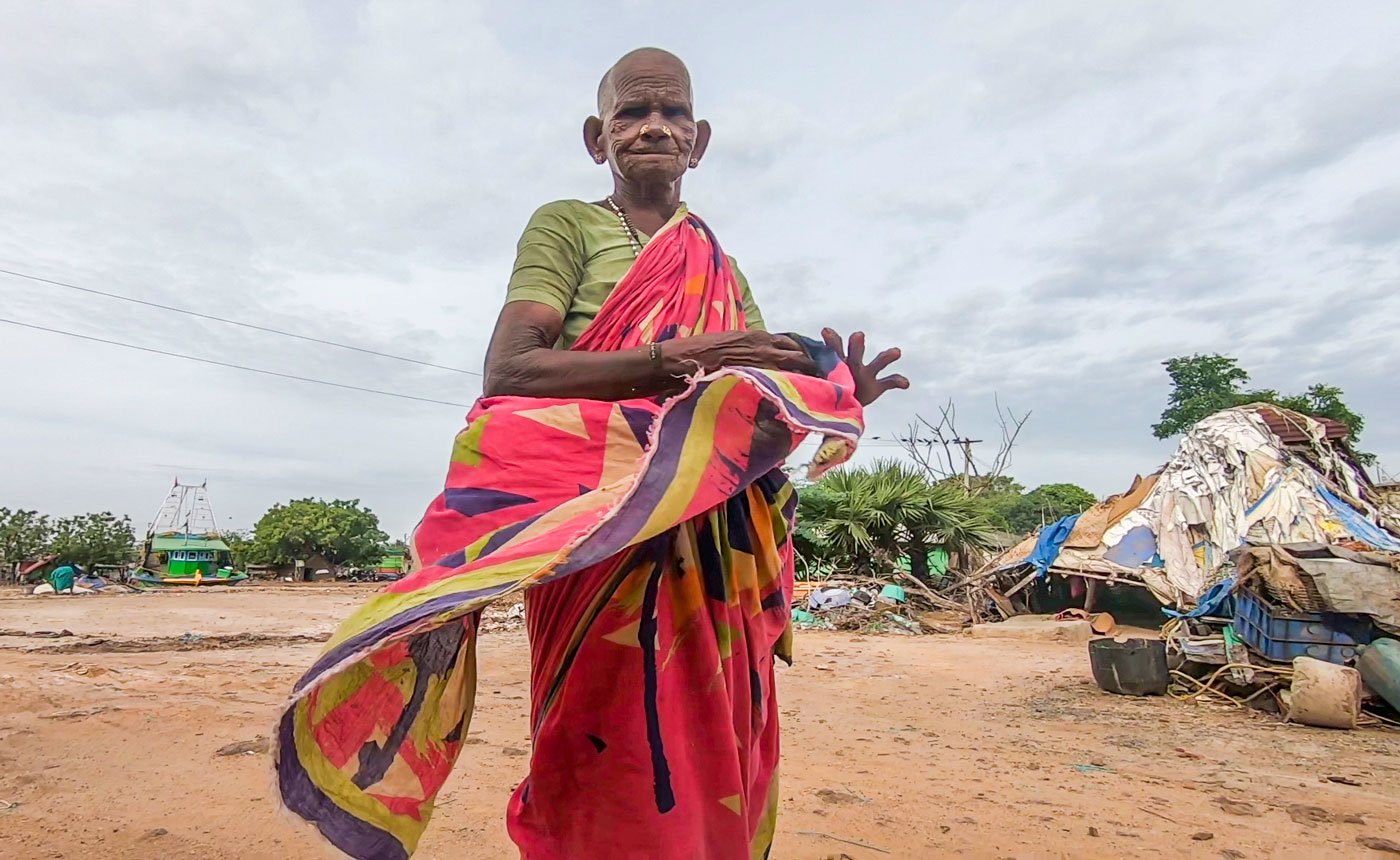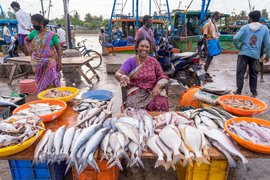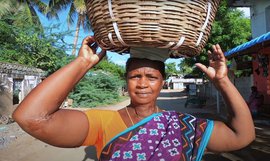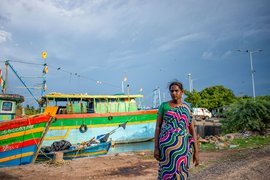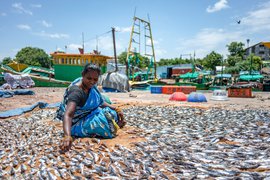ಅವರ ಅಜ್ಜ ಅವರಿಗಿರುವ ಶಕ್ತಿಗೆ ಸರಿಹೊಂದುವಂತೆ ಪುಲಿ ಎಂದು ಕರೆಯುತ್ತಿದ್ದರು. ತಮಿಳಿನಲ್ಲಿ ʼಪುಲಿʼ ಎಂದರೆ ಹುಲಿ - ಮತ್ತು ಕೆ. ಬಾನುಮತಿ ಈಗಲೂ ಬಂದರಿನಲ್ಲಿ ಅದೇ ಹೆಸರಿನಿಂದ ಕರೆಯಲ್ಪಡುತ್ತಾರೆ. ಅವರು ಇಲ್ಲಿ, ಸಮುದ್ರದ ಬಳಿ, 40 ವರ್ಷಗಳಿಂದ ಕೆಲಸ ಮಾಡುತ್ತಿದ್ದಾರೆ, ತ್ಯಾಜ್ಯದಿಂದ ಜೀವನೋಪಾಯವನ್ನು ಕಟ್ಟಿಕೊಂಡಿದ್ದಾರೆ - ಮೀನಿನ ಅವಶೇಷಗಳನ್ನು ಸಂಗ್ರಹಿಸುವುದು, ವಿಂಗಡಿಸುವುದು ಮತ್ತು ಮಾರಾಟ ಮಾಡುವುದು ಅವರ ಕೆಲಸ. ಆದರೆ ಪುಲಿ ಮತ್ತು ತಮಿಳುನಾಡಿನ ಕಡಲೂರು ಮೀನುಗಾರಿಕೆ ಬಂದರಿನಲ್ಲಿ ಕೆಲಸ ಮಾಡುವ ಇತರ ಅನೇಕ ಮಹಿಳೆಯರು ಸರ್ಕಾರದ ನೀತಿಗಳಲ್ಲಿ ಕಾರ್ಮಿಕರೆಂದು ಪರಿಗಣಿಸಲ್ಪಡುವುದಿಲ್ಲ ಮತ್ತು ಕಾರ್ಮಿಕರಿಗಾಗಿ ಇರುವ ಸೌಲಭ್ಯಗಳಿಂದ ವಂಚಿತರಾಗಿದ್ದಾರೆ.
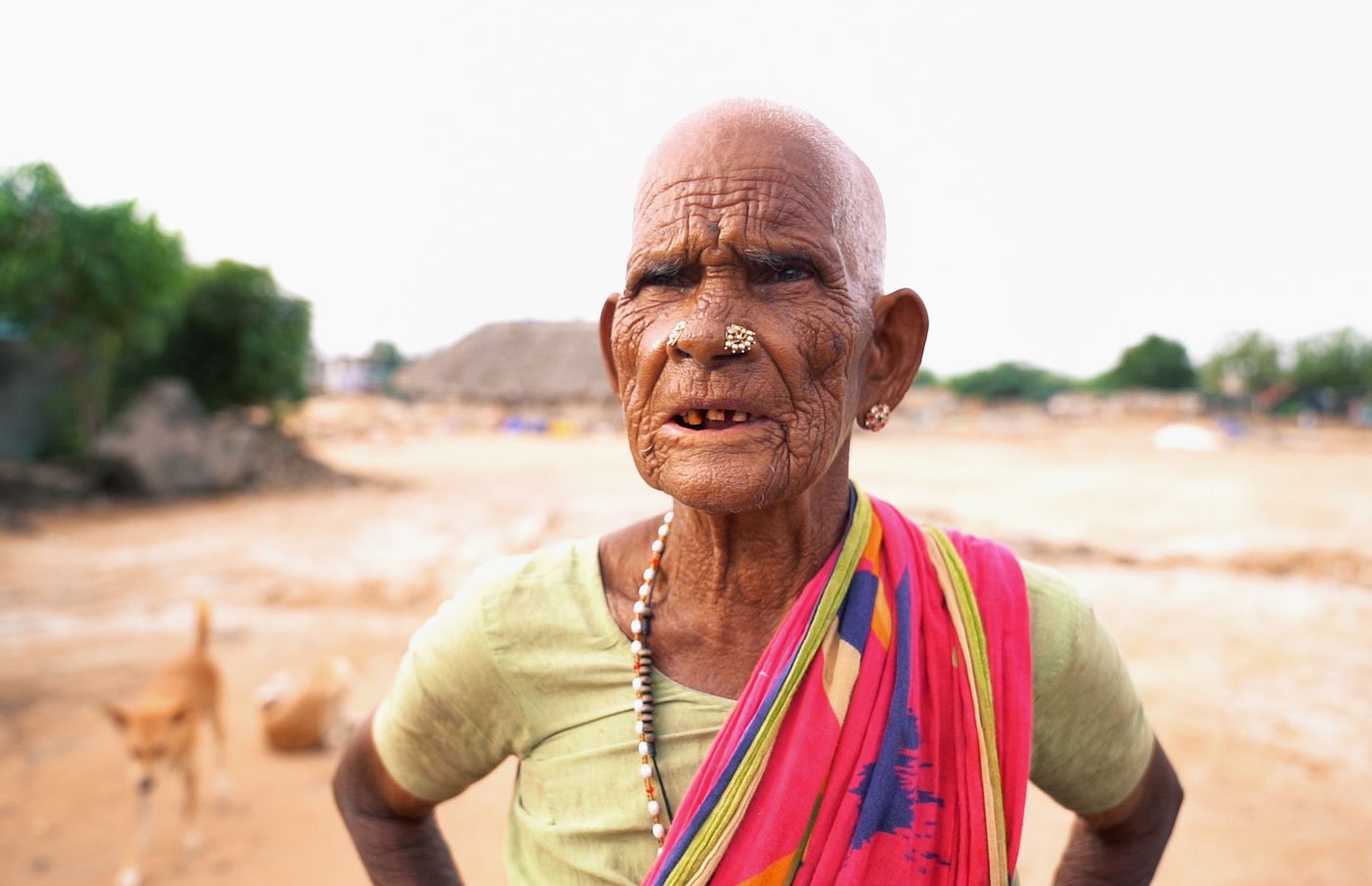
“ನಾನು 35 ವರ್ಷದವಳಿರುವಾಗ ಇಲ್ಲಿಗೆ ಮೀನು ಹರಾಜು ಹಾಕುವ ಕೆಲಸ ಮಾಡಲು ಆರಂಭಿಸಿದೆ.” ಎಂದು ಪ್ರಸ್ತುತ 75 ವರ್ಷ ಪ್ರಾಯದ ಪುಲಿ ಹೇಳುತ್ತಾರೆ. ನಗರದ ಪೂರ್ವದಲ್ಲಿರುವ ಕಡಲೂರು ಓಲ್ಡ್ ಟೌನ್ ಬಂದರಿನಲ್ಲಿ ಮೀನು ತುಂಬಿದ ದೋಣಿಗಳು ದಡಕ್ಕೆ ಬಂದಾಗ ಹರಾಜುದಾರರು ವ್ಯಾಪಾರಿಗಳಿಗಾಗಿ ಹರಾಜು ಕೂಗುತ್ತಾರೆ. ಅವರಿಗೆ ವ್ಯಾಪಾರವಾದ ಮೊತ್ತದ ಹತ್ತು ಶೇಕಡದಷ್ಟು ಮೊತ್ತ ಕಮಿಷನ್ ಆಗಿ ಸಿಗುತ್ತದೆ (20 ವರ್ಷಗಳ ಹಿಂದಿನವರೆಗೂ ಇದು ಐದು ಶೇಕಡಾದಷ್ಟಿತ್ತು.) ಇದಕ್ಕೆ ಅವರು ದೋಣಿಗೆ ಬಂಡವಾಳವನ್ನು ಹಾಕಿರಬೇಕು. ಮೂವತೈದು ವರ್ಷಗಳ ಹಿಂದೆ ಪುಲಿ ಅವರಿಗೆ ಅವರ ಸಂಬಂಧಿಕರೊಬ್ಬರು 50,000 ಸಾವಿರ ಸಾಲ ಕೊಡಿಸಿ, ಅದನ್ನು ಎರಡು ದೋಣಿಗಳಲ್ಲಿ ಬಂಡವಾಳವಾಗಿ ಹೂಡಿಕೆ ಮಾಡಿಸಿ ಈ ಬಂದರಿಗೆ ಪರಿಚಯಿಸಿದ್ದರು. ಅವರು ಹಗಲು ರಾತ್ರಿ ದುಡಿದು ಈ ಸಾಲವನ್ನು ತೀರಿಸಿ, ತನಗೆ ವಯಸ್ಸಾದ ನಂತರ ಈ ಹರಾಜು ಹಾಕುವ ಕೆಲಸವನ್ನು ಮಗಳಿಗೆ ಬಿಟ್ಟುಕೊಟ್ಟಿದ್ದಾರೆ.
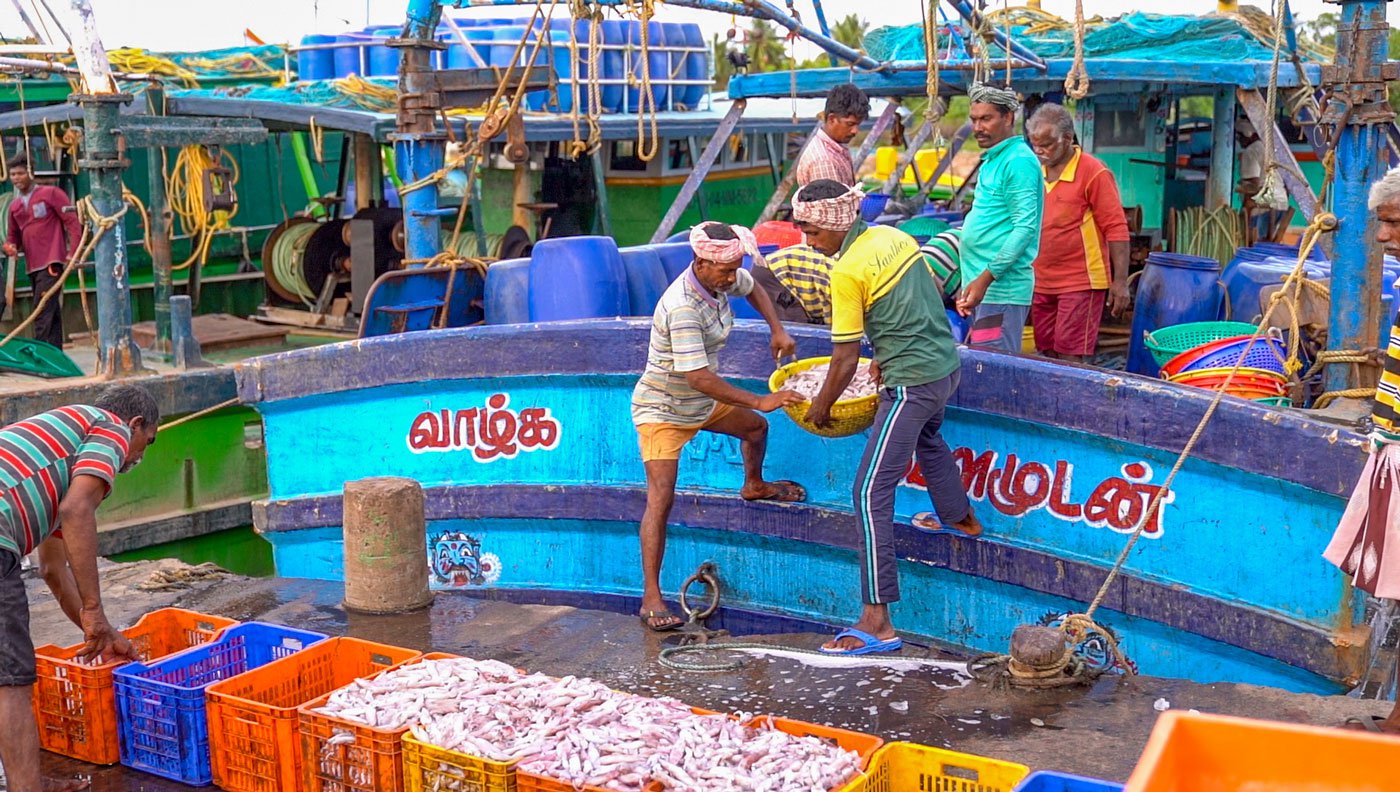
ಕಾರ್ಯನಿರತ ಬಂದರು ಸಾಮಾನ್ಯವಾಗಿ ಸದ್ದುಗದ್ದಲದಿಂದ ಕೂಡಿರುತ್ತದೆ – ಬಿಡ್ಗಳನ್ನು ಆಹ್ವಾನಿಸುವ ಹರಾಜುದಾರರು, ವ್ಯಾಪಾರಿಗಳು ತಿರುಗಾಡುತ್ತಿರುತ್ತಾರೆ, ಹಿಡಿದ ಮೀನನ್ನು ವರ್ಗಾಯಿಸುವ ಲೋಡರ್ ಗಳು, ಮಂಜುಗಡ್ಡೆಯನ್ನು ಪುಡಿಮಾಡುವ ಯಂತ್ರಗಳು, ಬಂದು ಹೋಗುವ ಲಾರಿಗಳು, ವ್ಯಾಪಾರ ಮಾಡುವ ಮಾರಾಟಗಾರರಿಂದ ಇದು ಸದಾ ಚಟುವಟಿಕೆಯಲ್ಲಿರುತ್ತದೆ. ಇದು ಕಡಲೂರು ಜಿಲ್ಲೆಯ ಪ್ರಮುಖ ಮೀನುಗಾರಿಕೆ ಬಂದರು ಮತ್ತು ಸೋಥಿಕುಪ್ಪಂ - ಪುಲಿಯ ಹಳ್ಳಿ - ಮತ್ತು ಇತರ ನಾಲ್ಕು ನೆರೆಯ ಮೀನುಗಾರಿಕಾ ಗ್ರಾಮಗಳಿಂದ ಮೀನುಗಾರರು ಬಳಸುತ್ತಾರೆ. ಸುಮಾರು ಒಂದು ದಶಕದ ಹಿಂದಿನವರೆಗೆ, ಈ ಐದು ಹಳ್ಳಿಗಳು ಒಟ್ಟಾಗಿ ಬಂದರಿನಲ್ಲಿ 256 ಯಾಂತ್ರೀಕೃತ ಮತ್ತು 822 ಯಾಂತ್ರಿಕ ದೋಣಿಗಳನ್ನು ಹೊಂದಿದ್ದವು ಎಂದು ಕೇಂದ್ರ ಸಾಗರ ಮೀನುಗಾರಿಕೆ ಸಂಶೋಧನಾ ಸಂಸ್ಥೆ ತಿಳಿಸುತ್ತದೆ. (ಇತ್ತೀಚಿನ ಅಂಕಿ-ಅಂಶಗಳು ಲಭ್ಯವಿಲ್ಲ.)
![“I’d started my kazhar business at the same time [as when I began working at the harbour],” Puli says, referring to her work of collecting and selling fish waste (the scales, heads, tails of fish, shrimp shells and other parts) and bycatch (such as seashells, shrimp, squid and small fishes). This is called kazhivu meen in Tamil, and, more informally, as kazhar. Puli is one of around 10 women at this harbour who collect fish waste and sell it to poultry feed manufacturers – it's a big industry in neighbouring districts like Namakkal. From Rs. 7 for one kilo of kazhar when she started out, the rate now, Puli says, is Rs. 30 per kilo for fish, Rs. 23 for fish heads and Rs. 12 for crab kazhar.](/media/images/04-Puli-3-NR-Puli_gets_by_on_shells_scales.max-1400x1120.jpg)
"ನಾನು ಕಳರ್ ವ್ಯವಹಾರವನ್ನು ಅದೇ ಸಮಯದಲ್ಲಿ (ನಾನು ಬಂದರಿನಲ್ಲಿ ಕೆಲಸ ಮಾಡಲು ಪ್ರಾರಂಭಿಸಿದಾಗ) ಪ್ರಾರಂಭಿಸಿದ್ದೆ", ಎಂದು ಪುಲಿ ಹೇಳುತ್ತಾರೆ. ಇಲ್ಲಿ ಕಳರ್ ವ್ಯವಹಾರವೆಂದರೆ ಮೀನಿನ ಅವಶೇಷಗಳು ಮತ್ತು ತಿನ್ನಲು ಉಪಯೋಗಿಸದ ಮೀನುಗಳು. (ಮೀನಿನ ಚರ್ಮ, ತಲೆಗಳು,ಬಾಲಗಳು, ಸೀಗಡಿಯ ಚಿಪ್ಪುಗಳು ಮತ್ತು ಇತರ ಭಾಗಗಳು) ಮತ್ತು ಮುಖ್ಯ ಮೀನುಗಳೊಡನೆ ಸಿಗುವ ಇತರೆ ಸಣ್ಣ ಪುಟ್ಟ ಮೀನುಗಳು (ಚಿಪ್ಪುಗಳು, ಸೀಗಡಿ , ಸ್ಕ್ವಿಡ್ ಮತ್ತು ಸಣ್ಣ ಮೀನುಗಳು). ಇದನ್ನು ತಮಿಳಿನಲ್ಲಿ ಕಾಳಿವು ಮೀನ್ ಎಂದು ಕರೆಯಲಾಗುತ್ತದೆ, ಮತ್ತು ಹೆಚ್ಚಾಗಿ ಇಲ್ಲಿ ಅನೌಪಚಾರಿಕವಾಗಿ, ಕಳರ್ ಎಂದು ಕರೆಯಲಾಗುತ್ತದೆ. ಈ ಬಂದರಿನಲ್ಲಿ ಪುಲಿಯವರೂ ಸೇರಿದಂತೆ ಇಲ್ಲಿ ಸುಮಾರು ಹತ್ತು ಮಹಿಳೆಯರು ಈ ಕೆಲಸದಲ್ಲಿದ್ದಾರೆ. ಅವರು ಇವುಗಳನ್ನೆಲ್ಲ ಸಂಗ್ರಹಿಸಿ ಕೋಳಿ ಆಹಾರ ತಯಾರಕರಿಗೆ ಮಾರುತ್ತಾರೆ. ಇದು ನಾಮಕ್ಕಲ್ನಂತಹ ನೆರೆಯ ಜಿಲ್ಲೆಗಳಲ್ಲಿ ದೊಡ್ಡ ವ್ಯವಹಾರ. ಅವರು ಹಿಂದೆ ಈ ಕೆಲಸ ಆರಂಭಿಸಿದ ದಿನಗಳಲ್ಲಿ ಕೇಜಿಗೆ ಏಳು ರೂಪಾಯಿಗಳಿಷ್ಟಿತ್ತು ಎನ್ನುವ ಪುಲಿ, ಈಗ ಮೀನುಗಳಿಗೆ 30 ರೂಪಾಯಿ, ಮೀನಿನ ತಲೆಗೆ 23 ರೂಪಾಯಿ ಮತ್ತು ಏಡಿ ಕಳರ್ಗೆ 12 ರೂ.ಗಳಷ್ಟಿದೆ ಎನ್ನುತ್ತಾರೆ.
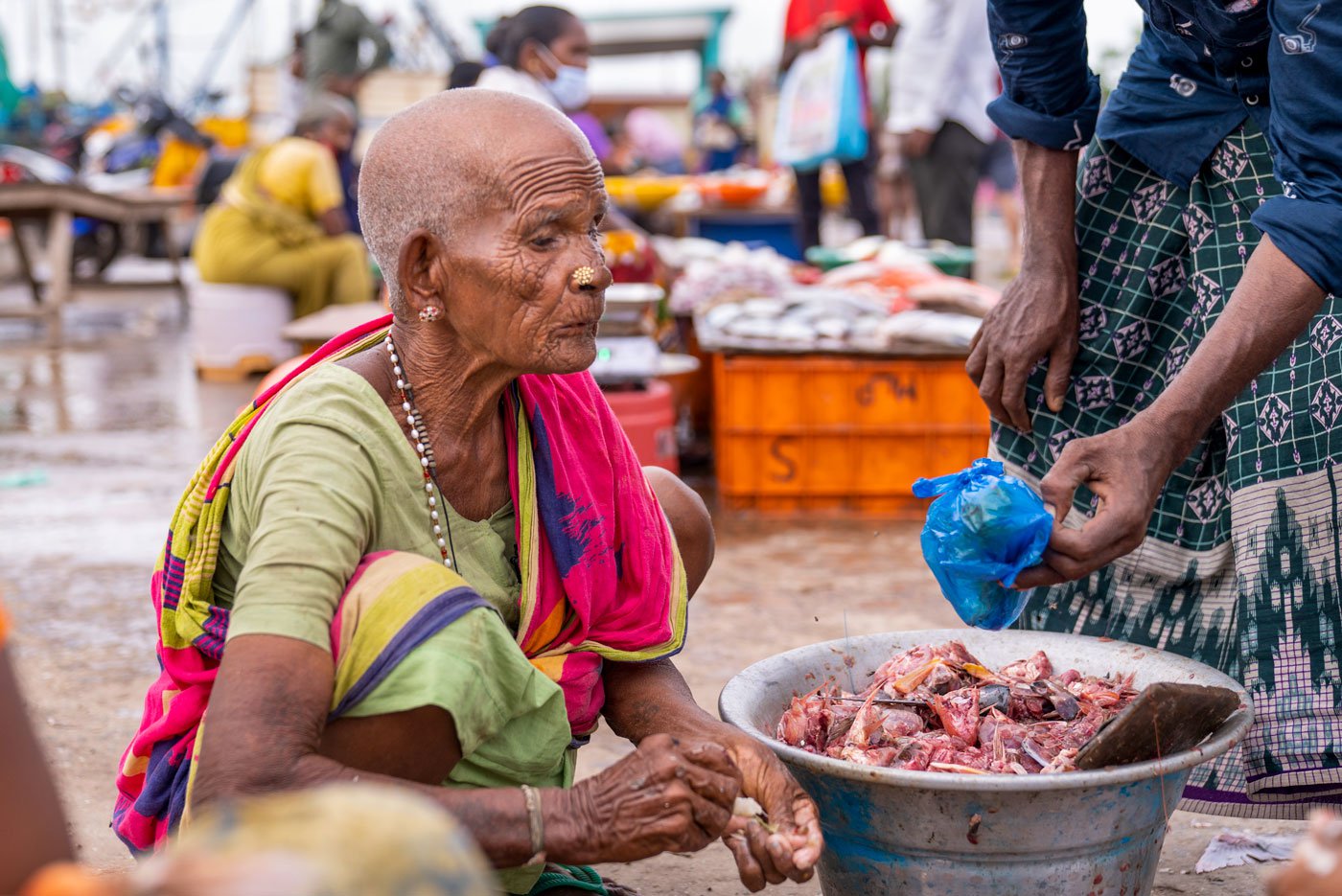
ಅವರು 16 ವರ್ಷದವರಾಗಿದ್ದಾಗ, ಪುಲಿ ನಾಗಪಟ್ಟಿಣಂ ಜಿಲ್ಲೆಯ ಮೀನುಗಾರನನ್ನು ಮದುವೆಯಾದರು. ಅವರಿಗೆ ನಾಲ್ಕು ಮಕ್ಕಳಿದ್ದರು, ಆದರೆ ಅವರ ಪತಿ ಕುಪ್ಪುಸಾಮಿ ಬಹಳ ಹಿಂಸೆ ನೀಡುತ್ತಿದ್ದರು. ಆದ್ದರಿಂದ ಸೋಥಿಕುಪ್ಪಂನಲ್ಲಿ ಪಂಚಾಯತ್ ನಾಯಕರಾದ ಅವಳ ತಂದೆ ಮಕ್ಕಳೊಂದಿಗೆ ಮನೆಗೆ ಮರಳುವಂತೆ ಹೇಳಿದರು. ಅವರು ಮೂರು ವರ್ಷಗಳ ನಂತರ ತನ್ನ ತಾಯಿಯನ್ನು ಕಳೆದುಕೊಂಡರು, ಅವರು ಕೂಡಾ ಹರಾಜುದಾರರಾಗಿ ಕೆಲಸ ಮಾಡುತ್ತಿದ್ದರು. ಆಗ ನನ್ನ ಸಂಬಂಧಿಕರು ಹರಾಜು ಆರಂಭಿಸಲು ಹೇಳಿದರು' ಎನ್ನುತ್ತಾರೆ ಪುಲಿ. "ನನ್ನ ಮಕ್ಕಳನ್ನು ನೋಡಿಕೊಳ್ಳಲು ನನಗೆ ಹಣ ಬೇಕಾಗಿತ್ತು."
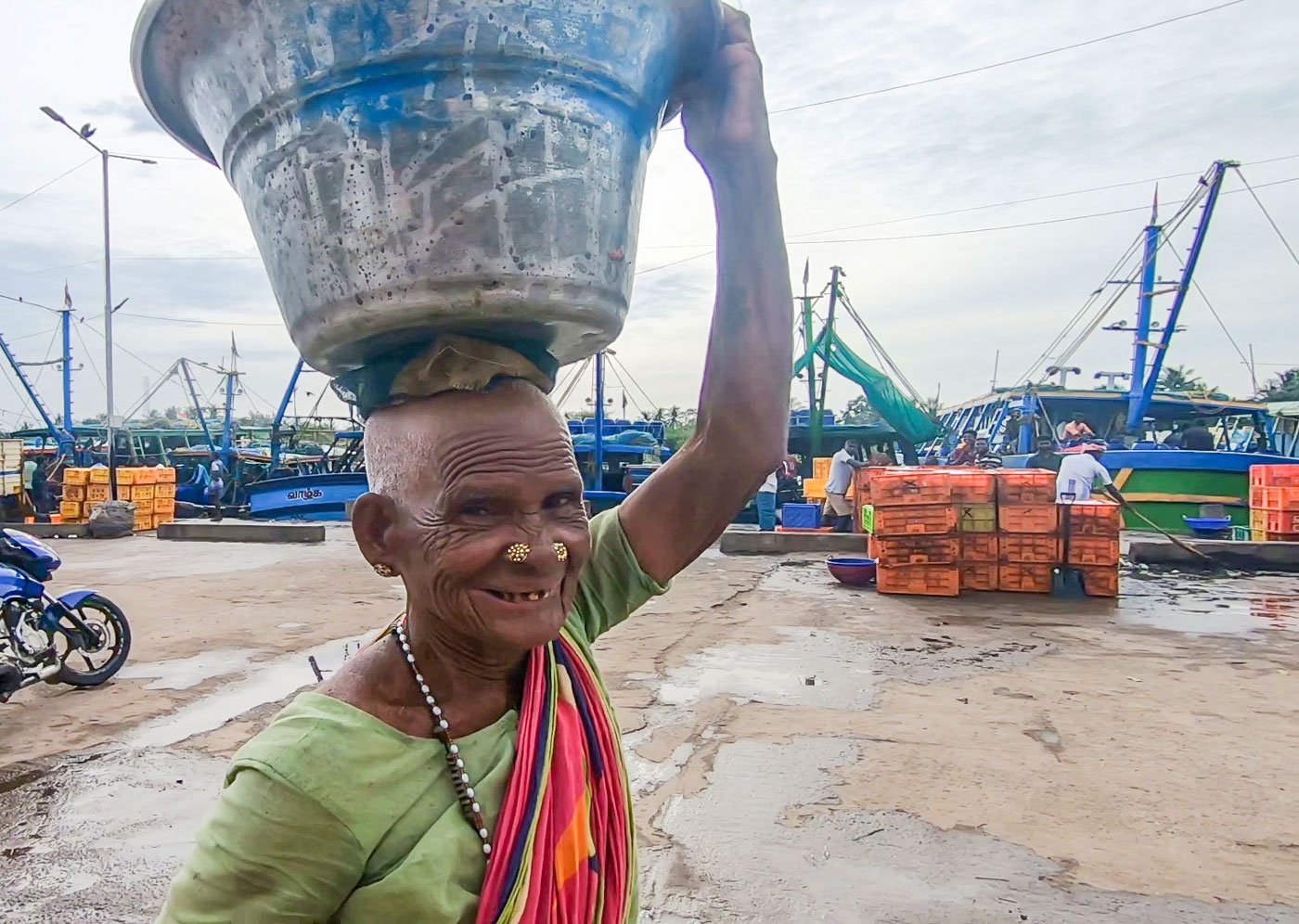
ಅವರು ಬೆಳಗಿನ ಜಾವ ನಾಲ್ಕರಿಂದ ಸಂಜೆ ಆರು ಗಂಟೆಯ ತನಕ ಬಂದರಿನಲ್ಲಿ ಉಪ್ಪು ಹಾಕುವುದು, ಪ್ಯಾಕಿಂಗ್ ಮಾರುವುದನ್ನು ಮಾಡುತ್ತಾರೆ. ಕಳರ್ ಸಂಗ್ರಹಿಸಿದ ಮೊದಲ ದಿನ ಅದರ ವಾಸನೆಯನ್ನು ಕಡಿಮೆ ಮಾಡಲು ಉಪ್ಪು ಹಾಕಲಾಗುತ್ತದೆ. ಮರುದಿನ ಅದನ್ನು ಮೆಶ್ ಬ್ಯಾಗಿನಲ್ಲಿ ಹಾಕಿ ಪ್ಯಾಕ್ ಮಾಡಲಾಗುತ್ತದೆ. ಈ ಚೀಲವನ್ನು ಅವರು ನಾಲ್ಕು ರೂಪಾಯಿಗಳಿಗೆ ಒಂದರಂತೆ ಬಂದರಿನಲ್ಲಿ ಖರೀದಿಸುತ್ತಾರೆ. ಕೆಲವೊಮ್ಮೆ 15 ರೂಪಾಯಿಗಳ ಸೆಣಬಿನ ಚೀಲವನ್ನೂ ಖರೀದಿಸುತ್ತಾರೆ.
ಒಂದು ಚೀಲ ಕಳರ್ 25 ಕೇಜಿಗಳಷ್ಟು ತೂಗುತ್ತದೆ ಎನ್ನುತ್ತಾರೆ ಪುಲಿ. ಮೊದಲು ವಾರಕ್ಕೆ 4 – 5 ಬ್ಯಾಗುಗಳಷ್ಟು ಕಳರ್ ಮಾರುತ್ತಿದ್ದರು. ಆದರೆ ಕೋವಿಡ್ - 19 ಮಹಾಮಾರಿ ಮತ್ತು ರಿಂಗ್ ಸೀನ್ ಬಲೆಗಳ ನಿಷೇಧ ಮತ್ತು ಮೀನುಗಳ ಹಿಡಿಯುವಿಕೆ ಮತ್ತು ವ್ಯಾಪಾರದಲ್ಲಿನ ಕುಸಿತದಿಂದಾಗಿ ಈಗ ಅವರು ವಾರಕ್ಕೆ ಎರಡು ಚೀಲಗಳನ್ನಷ್ಟೇ ಸಂಗ್ರಹಿಸಲು ಸಾಧ್ಯವಾಗುತ್ತಿದೆ. ಇದನ್ನು ನಾಮಕ್ಕಲ್ನ ವ್ಯಾಪಾರಿಗಳಿಗೆ ಮಾರಿದರೆ ಅವರಿಗೆ ವಾರಕ್ಕೆ ಸುಮಾರು 1,250 ರೂಪಾಯಿಗಳಷ್ಟು ದೊರೆಯುತ್ತದೆ.
ಕಡಲೂರು ಬಂದರಿನಲ್ಲಿ ಹರಾಜುದಾರರು, ಮಾರಾಟಗಾರರು, ಮೀನು ಒಣಗಿಸುವವರು ಅಥವಾ ಕಳರ್ ವಿಂಗಡಿಸುವವರು – ಹೀಗೆ ಎಲ್ಲಾ ಕಾರ್ಯಗಳಲ್ಲಿ ತೊಡಗಿರುವ ಮಹಿಳೆಯರು ತಮ್ಮ ದೈನಂದಿನ ಆದಾಯದ ಅನಿಶ್ಚಿತತೆಗಳ ಬಗ್ಗೆ ಮಾತನಾಡುತ್ತಾರೆ. ಮೀನುಗಾರಿಕಾ ಹಳ್ಳಿಗಳಲ್ಲಿನ ಅನೇಕ ಕಿರಿಯ ಮಹಿಳೆಯರು ಮೀನುಗಾರಿಕೆಯಿಂದ ದೂರವಿರಲು ಬಯಸುತ್ತಾರೆ. ಇದರ ಪರಿಣಾಮವಾಗಿ, ಸಾಮಾನ್ಯವಾಗಿ ವಯಸ್ಸಾದ ಮಹಿಳೆಯರು ಬಂದರಿನಲ್ಲಿ ಕೆಲಸ ಮಾಡುತ್ತಾರೆ.
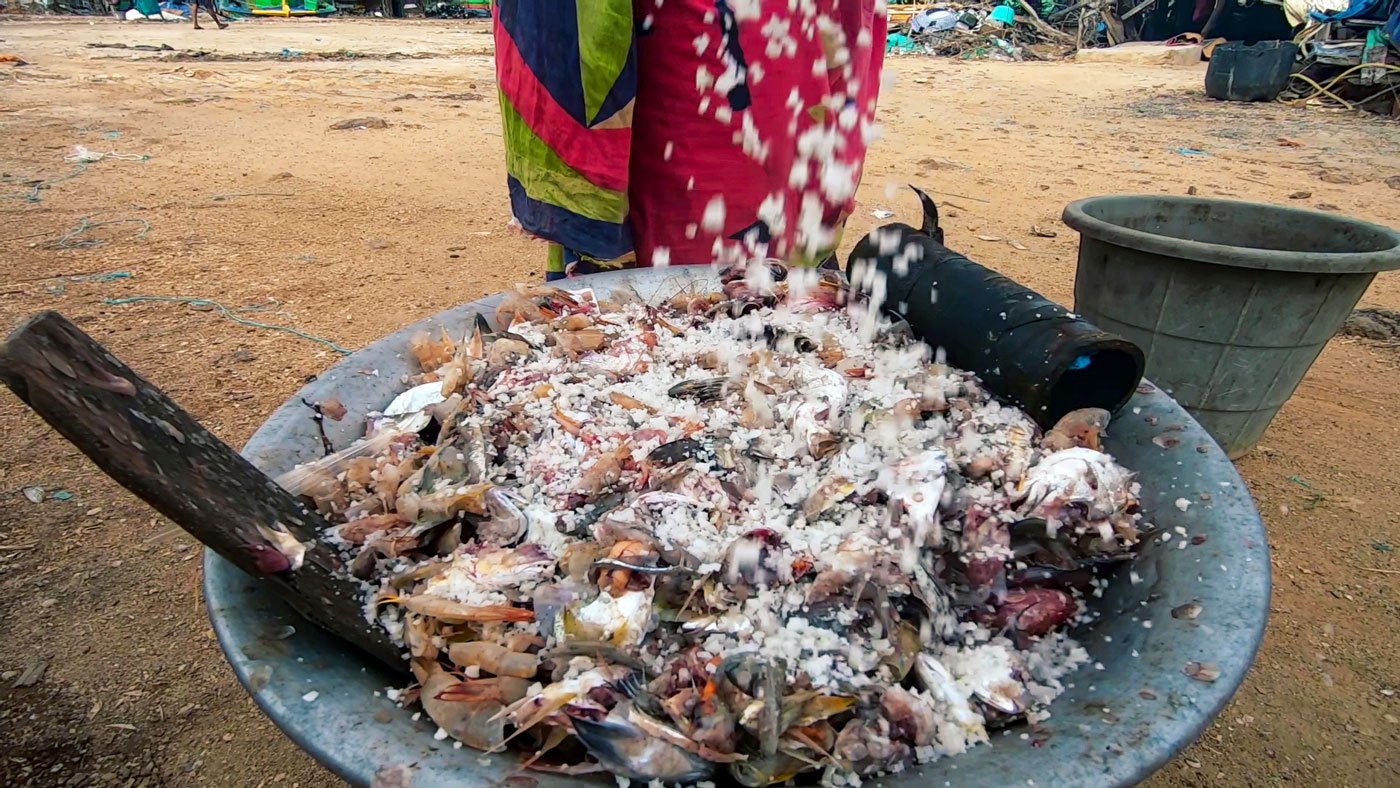
"ನಾನು ಕಳರ್ಗೆ ಹಣ ನೀಡುವುದಿಲ್ಲ" ಎಂದು ಪುಲಿ ಹೇಳುತ್ತಾರೆ. "ಬಂದರಿನಲ್ಲಿ ಮೀನು ಕತ್ತರಿಸುವ ಮಹಿಳೆಯರಿಂದ ನಾನು ಅದನ್ನು ಸಂಗ್ರಹಿಸುತ್ತೇನೆ." ಪ್ರತಿದಿನ, ಬೆಳಗಿನ ಜಾವ 4 ಗಂಟೆಗೆ, ಅವರು ಗ್ರಾಹಕರ ಅಗತ್ಯಗಳಿಗೆ ಅನುಗುಣವಾಗಿ ಚರ್ಮ ಮತ್ತು ಕರುಳನ್ನು ತೆಗೆದುಹಾಕುವ ಮಾರಾಟಗಾರರು ಮತ್ತು ಇತರರಿಂದ ಮೀನು ತ್ಯಾಜ್ಯವನ್ನು ಸಂಗ್ರಹಿಸಲು ಪ್ರಾರಂಭಿಸುತ್ತಾರೆ. ಪುಲಿ ಕಳರ್ಗೆ ಹಣ ನೀಡದಿದ್ದರೂ, ಕೆಲವೊಮ್ಮೆ ಮಾರಾಟಗಾರರು ಮತ್ತು ಮೀನು ಕತ್ತರಿಸುವವರಿಗೆ ತಂಪು ಪಾನೀಯಗಳನ್ನು ಖರೀದಿಸಿ ಕೊಡಿಸುತ್ತಾರೆ. "ನಾನು ಅವರ ಕೆಲಸದ ಜಾಗವನ್ನು ಸ್ವಚ್ಛಗೊಳಿಸಲು ಸಹಾಯ ಮಾಡುತ್ತೇನೆ," ಅವರು ಹೇಳುತ್ತಾರೆ, "ಅವರೊಂದಿಗೆ ಅದೂ ಇದೂ ಮಾತನಾಡುವುದೂ ಇರುತ್ತದೆ."
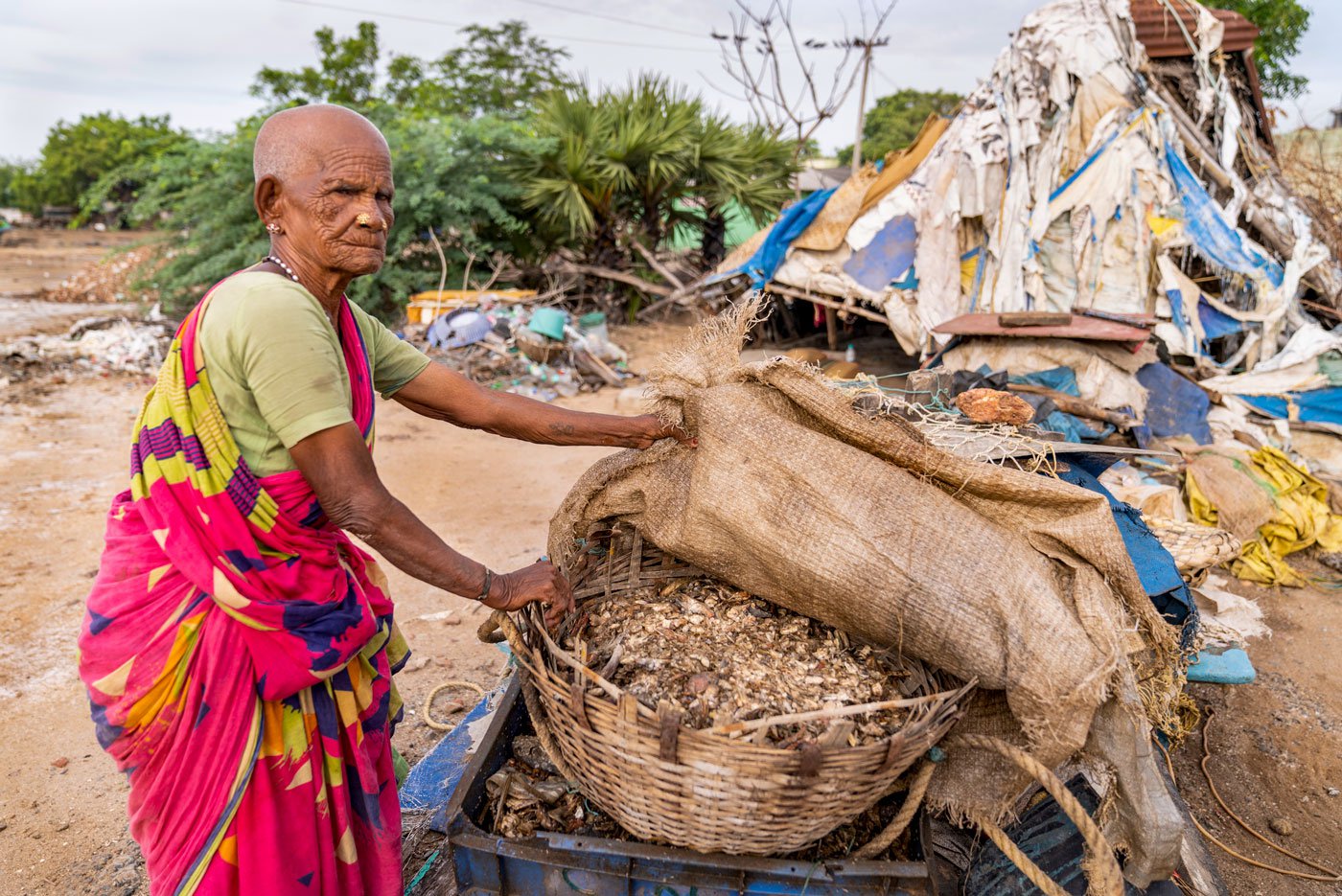
ಕಡಲೂರು ಬಂದರಿನ ಮಹಿಳೆಯರು ಮೀನು ಮಾರಾಟ ಮತ್ತು ಸಂಸ್ಕರಣೆಗೆ ನೇರವಾಗಿ ಸಂಬಂಧಿಸಿದ ವ್ಯಾಪಕ ಶ್ರೇಣಿಯ ಕಾರ್ಯಗಳಲ್ಲಿ ತೊಡಗಿದ್ದಾರೆ, ಮತ್ತು ಪರೋಕ್ಷವಾಗಿ ಮೀನುಗಾರಿಕೆ ಕಾರ್ಮಿಕರಿಗೆ ಐಸ್, ಚಹಾ ಮತ್ತು ಬೇಯಿಸಿದ ಆಹಾರವನ್ನು ಮಾರಾಟ ಮಾಡುವಂತಹ ವಿವಿಧ ಬೆಂಬಲ ಕಾರ್ಯಗಳಲ್ಲಿ ತೊಡಗಿಸಿಕೊಂಡಿದ್ದಾರೆ. ರಾಷ್ಟ್ರೀಯ ಮೀನುಗಾರಿಕೆ ನೀತಿ 2020 ಹೇಳುವಂತೆ, ಕೊಯ್ಲಿನ ನಂತರದ ಎಲ್ಲಾ ಮೀನುಗಾರಿಕೆ ಚಟುವಟಿಕೆಗಳಲ್ಲಿ ಮಹಿಳೆಯರು ಶೇಕಡಾ 69ರಷ್ಟಿದ್ದಾರೆ. ಈ ಕಾರ್ಯಗಳನ್ನು ಎಣಿಸಿದರೆ, ಮೀನುಗಾರಿಕೆಯನ್ನು ಪ್ರಮುಖವಾಗಿ ಮಹಿಳಾ ವಲಯವಾಗಿ ನೋಡಬಹುದು.
2020ರ ನೀತಿಯು ಸಹಕಾರಿ ಸಂಸ್ಥೆಗಳು, ಯೋಜನೆಗಳು ಮತ್ತು ಕೆಲಸದ ಪರಿಸ್ಥಿತಿಗಳನ್ನು ಸುಧಾರಿಸಲು ಇತರ ಕ್ರಮಗಳ ಮೂಲಕ ಮೀನುಗಾರಿಕೆಯಲ್ಲಿ ಮಹಿಳೆಯರ ಪಾಲ್ಗೊಳ್ಳುವಿಕೆಯನ್ನು ಹೆಚ್ಚಿಸುವ ಅಗತ್ಯವನ್ನು ಒಪ್ಪಿಕೊಳ್ಳುತ್ತದೆ. ಆದಾಗ್ಯೂ, ಅಂತಹ ಯೋಜನೆಗಳ ಗಮನವು ಸಾಮಾನ್ಯವಾಗಿ ಸುಗ್ಗಿಯ ನಂತರದ ಮೀನುಗಾರಿಕೆಯಲ್ಲಿ ತೊಡಗಿರುವ ಮಹಿಳೆಯರ ದೈನಂದಿನ ಸಮಸ್ಯೆಗಳಿಗಿಂತ ಯಾಂತ್ರೀಕರಣದ ಮೇಲೆ ಕೇಂದ್ರೀಕೃತವಾಗಿದೆ.
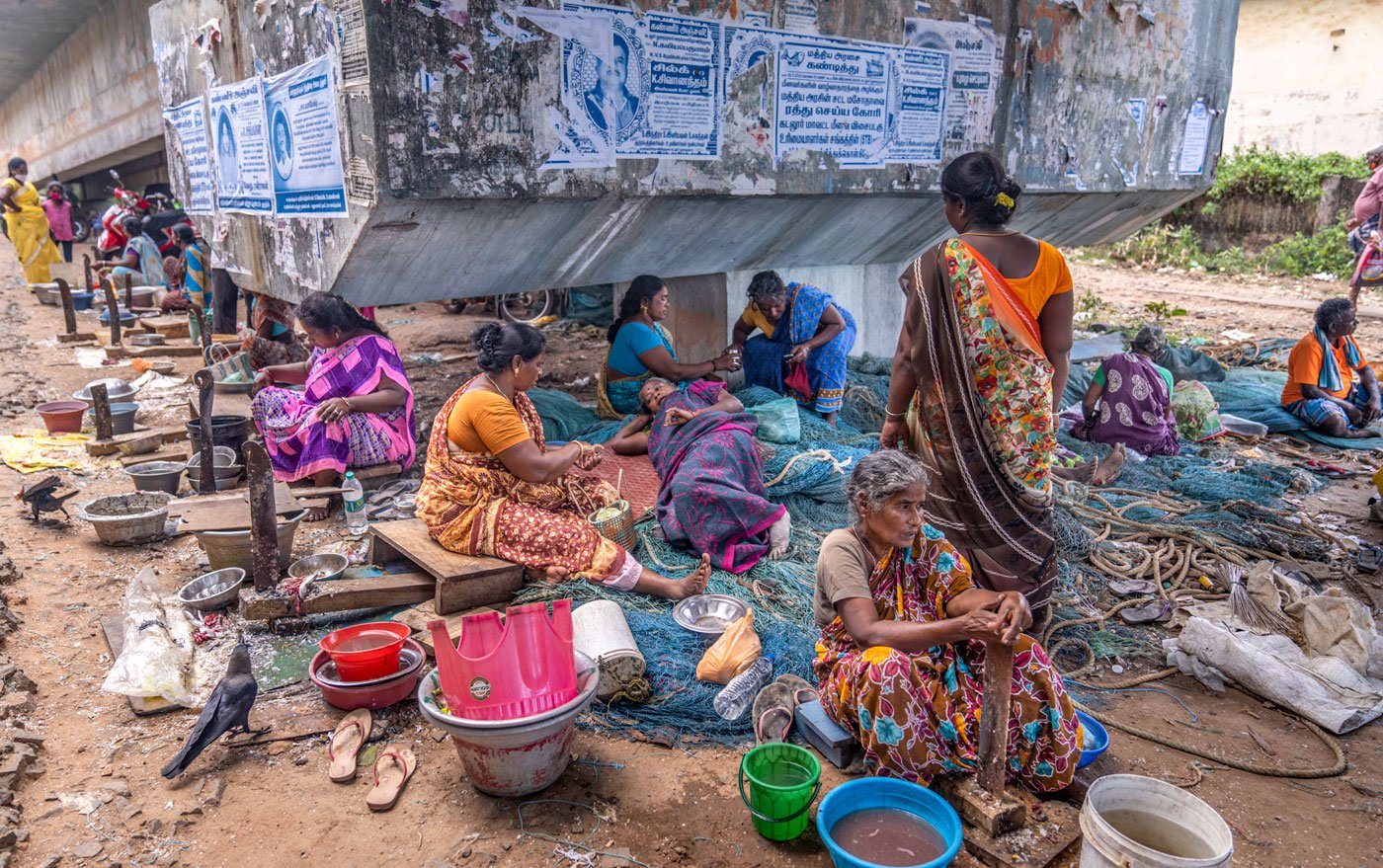
ಮತ್ತು ಮೀನುಗಾರಿಕೆಯಲ್ಲಿ ಮಹಿಳೆಯರಿಗೆ ಸಹಾಯ ಮಾಡುವ ಕ್ರಮಗಳ ಬದಲಿಗೆ, ಕರಾವಳಿ ಪರಿವರ್ತನೆಗಳು ಮತ್ತು ಬಂಡವಾಳ-ತೀವ್ರ ಮೀನುಗಾರಿಕೆ ಮತ್ತು ರಫ್ತು ಉತ್ತೇಜನದ ಕಡೆಗೆ ನೀತಿಯ ಒತ್ತಡದಿಂದಾಗಿ ಅವರು ಹೆಚ್ಚು ಹೆಚ್ಚು ಅಂಚಿಗೆ ತಳ್ಳಲ್ಪಟ್ಟಿದ್ದಾರೆ. ಈ ಬದಲಾವಣೆಗಳು ಈ ವಲಯಕ್ಕೆ ಮಹಿಳೆಯರ ಕೊಡುಗೆಗಳನ್ನು ಗುರುತಿಸುವುದಿಲ್ಲ. ಬೃಹತ್ ಮೂಲಸೌಕರ್ಯದಲ್ಲಿ ಹೆಚ್ಚಿದ ಹೂಡಿಕೆ ಮತ್ತು 1972ರಲ್ಲಿ ಸಾಗರ ಉತ್ಪನ್ನಗಳ ರಫ್ತು ಅಭಿವೃದ್ಧಿ ಪ್ರಾಧಿಕಾರವನ್ನು ಸ್ಥಾಪಿಸುವುದು ಸೇರಿದಂತೆ ಇತರ ಕ್ರಮಗಳು ಅವರ ಕಡೆಗಣನೆಯನ್ನು ಹೆಚ್ಚಿಸಿವೆ, ಇದು ರಫ್ತುಗಳನ್ನು ಹೆಚ್ಚಿಸಿತು ಮತ್ತು ಸಣ್ಣ ಪ್ರಮಾಣದ ಮೀನುಗಾರಿಕೆಯನ್ನು ನಿರಾಕರಿಸಿತು. 2004ರ ಸುನಾಮಿಯ ನಂತರ ಈ ಪ್ರಕ್ರಿಯೆಯು ಮತ್ತಷ್ಟು ವೇಗವನ್ನು ಪಡೆಯಿತು, ಹೊಸ ದೋಣಿಗಳು ಮತ್ತು ಉಪಕರಣಗಳಲ್ಲಿ ಹಣವನ್ನು ಹೂಡಿಕೆ ಮಾಡಲಾಯಿತು.
ಕಾಲಾನಂತರದಲ್ಲಿ, ಹೆಚ್ಚು ಹೆಚ್ಚು ಸ್ಥಳೀಯ ಮಹಿಳೆಯರನ್ನು ಮೀನು ಕೊಯ್ಲಿನ ನಂತರದ ಚಟುವಟಿಕೆಗಳಿಂದ ಹೊರಗಿಡಲಾಗಿದೆ. ಕಡಲೂರು ಬಂದರಿನ ಮಹಿಳೆಯರು ತಮ್ಮ ಕಾರ್ಯಗಳಿಗೆ ಸ್ಥಳದ ಕೊರತೆಯ ಬಗ್ಗೆ ಮಾತನಾಡುತ್ತಾರೆ, ಉದಾಹರಣೆಗೆ ಮೀನು ಕತ್ತರಿಸುವುದು. ಮಾರುವುದು, ಒಣಗಿಸುವುದು, ಅಥವಾ ತ್ಯಾಜ್ಯ ವಿಲೇವಾರಿ ಮಾಡುವುದು. ಕೆಲವು ಮಹಿಳಾ ಮಾರಾಟಗಾರರಿಗೆ ಮಾತ್ರ ಸರ್ಕಾರಿ ಸಂಸ್ಥೆಗಳು ಐಸ್ ಬಾಕ್ಸ್ ಗಳನ್ನು ಒದಗಿಸುತ್ತವೆ, ಮತ್ತು ಕೆಲವು ಹಳ್ಳಿಗಳು ಮತ್ತು ಪಟ್ಟಣಗಳು ಮಾತ್ರ ಮಾರುಕಟ್ಟೆಗಳಲ್ಲಿ ಅವರಿಗೆ ಸ್ಥಳಗಳನ್ನು ಹಂಚಿಕೆ ಮಾಡಿವೆ. ಆಗಾಗ್ಗೆ, ಸಾರಿಗೆ ಸೌಲಭ್ಯಗಳ ಅನುಪಸ್ಥಿತಿಯಲ್ಲಿ, ಅವರು ದೂರದ ಸ್ಥಳಗಳಲ್ಲಿ ಮೀನುಗಳನ್ನು ಮಾರಾಟ ಮಾಡಲು ಬಹಳ ದೂರ ನಡೆದುಕೊಂಡೇ ಹೋಗಬೇಕಿರುತ್ತದೆ.
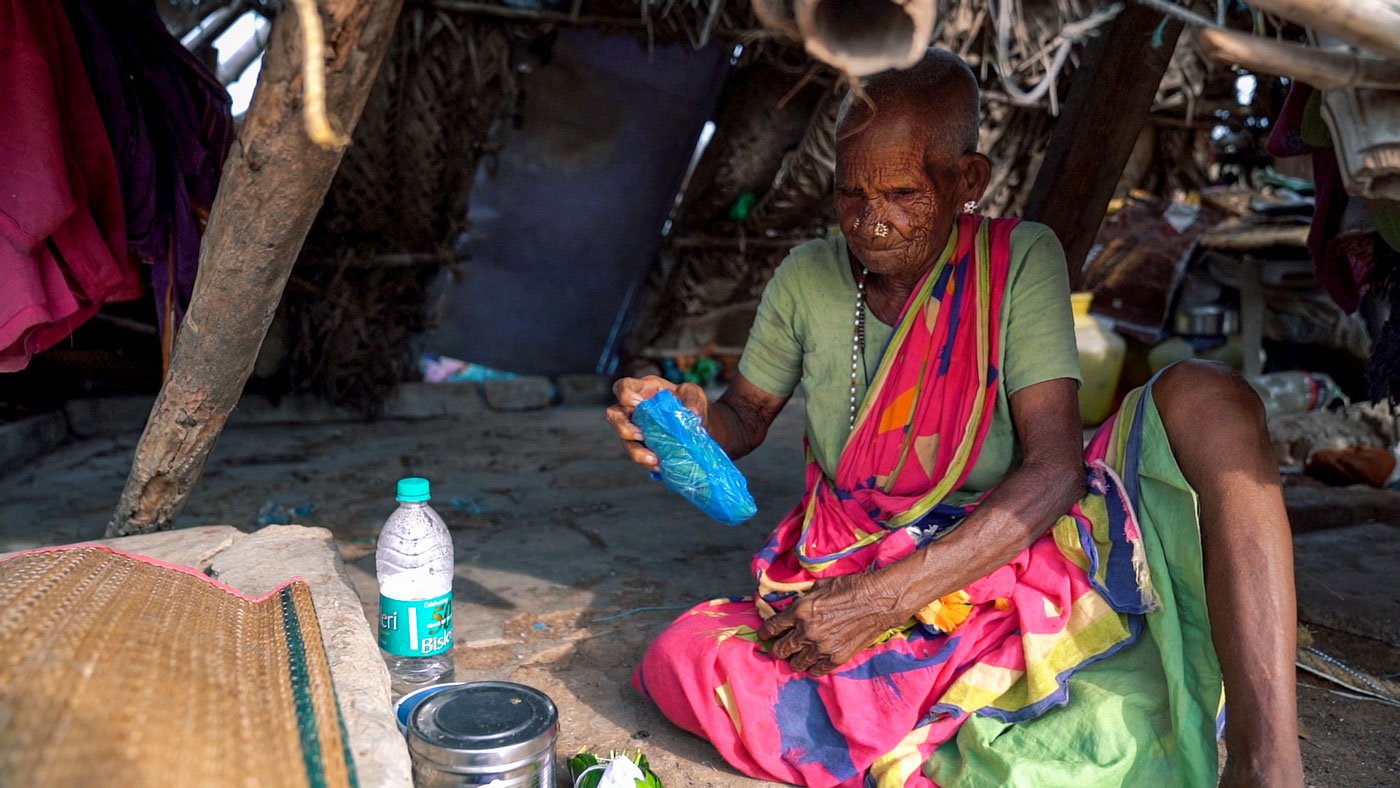
"ನಾನು ಇಲ್ಲಿ ಬಂದರಿನಲ್ಲಿ ಒಂದು ಸಣ್ಣ ಗುಡಿಸಲಿನಲ್ಲಿ ವಾಸಿಸುತ್ತಿದ್ದೇನೆ, ಇದರಿಂದ ನಾನು ನನ್ನ ವ್ಯವಹಾರಕ್ಕೆ ಹತ್ತಿರದಲ್ಲೇ ಇದ್ದೇನೆ" ಎಂದು ಪುಲಿ ಹೇಳುತ್ತಾರೆ. ಆದರೆ ಮಳೆ ಬಂದಾಗ ಅವರು ಸುಮಾರು ಮೂರು ಕಿಲೋಮೀಟರ್ ದೂರದ ಸೊತಿಕುಪ್ಪಂನಲ್ಲಿರುವ ತನ್ನ ಮಗ ಮುತ್ತುವಿನ ಮನೆಗೆ ಹೋಗುತ್ತಾರೆ. ಬಂದರಿನಲ್ಲಿ ಮೀನುಗಾರನಾಗಿರುವ 58 ವರ್ಷದ ಮುತ್ತು ಪ್ರತಿದಿನ ತಾಯಿಗಾಗಿ ಆಹಾರವನ್ನು ಕೆಲಸದ ಸ್ಥಳಕ್ಕೆ ತರುತ್ತಾರೆ, ಮತ್ತು ಪ್ರತಿ ತಿಂಗಳು ಅವರಿಗೆ 1,000 ರೂ. ವೃದ್ಧಾಪ್ಯ ಪಿಂಚಣಿ ಬರುತ್ತದೆ. ಪುಲಿ ತನ್ನ ಹೆಚ್ಚಿನ ಮೀನು ಕೆಲಸದ ಆದಾಯವನ್ನು ತನ್ನ ಮಕ್ಕಳಿಗೆ ಕಳುಹಿಸುತ್ತಾರೆ. ಅವರಿಗೆ ಇಬ್ಬರು ಗಂಡು ಮಕ್ಕಳು ಮತ್ತು ಇಬ್ಬರು ಹೆಣ್ಣುಮಕ್ಕಳು, ಎಲ್ಲರೂ 40 ಮತ್ತು 50ರ ಪ್ರಾಯದವರು ಮತ್ತು ಕಡಲೂರು ಜಿಲ್ಲೆಯ ಮೀನುಗಾರಿಕೆ ವಲಯದಲ್ಲಿ ಕೆಲಸ ಮಾಡುತ್ತಿದ್ದಾರೆ. "ನಾನು ನನ್ನೊಂದಿಗೆ ಏನು ತಗೊಂಡು ಹೋಗ್ತೀನಿ?" ಅವರು ಕೇಳುತ್ತಾರೆ. "ಏನೂ ಇಲ್ಲ."
ಯು. ಧಿವ್ಯಥಿರನ್ ಅವರ ಸಹಾಯದೊಂದಿಗೆ.
ಅನುವಾದ: ಶಂಕರ. ಎನ್. ಕೆಂಚನೂರು
